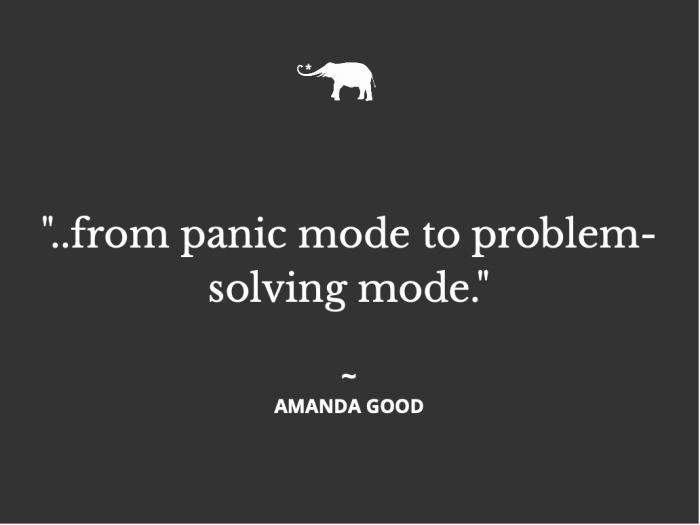I’ve used many different mantras over the years with clients and for my own stress management, but I’ve learned a new one this week: “Semper Gumby.”
Remember the super stretchy green character from the clay animation TV show back in the day?
It’s a pretty great visual for being flexible.
Semper Gumby is a funny spin on the Marine Corps motto Semper Fidelis which means “always loyal,” as well as the Coast Guard’s, Semper Paratus or “always ready.” The Gumby spin-off is apparently a common military phrase that my husband learned during his time in the army, and it implies remaining flexible.
My husband said this to our contractor when we hit a delay in our home renovation project, and it really resonated with me. It turned a stressful snag in plans into a chuckle and a conversation about going with the flow, since these speed bumps are bound to happen.
The night before, I pretty quickly panicked when I saw a mistake in our plans, and sent a flurry of text messages to our team. I worried that either it couldn’t be fixed, or it would be a huge setback in the length of the project, which has already felt long and stressful. My mindfulness teachings went out the window, drowned out by my “Oh no!” and “What if?” stress-induced thoughts.
Semper Gumby was my reminder to come back to a mindful and flexible way of thinking, and handling the situation, instead of getting overwhelmed.
It moved us from panic mode to problem-solving mode.
When stressors present themselves, there are two options for responding: “oh, no!” (the worried, hopeless, overwhelmed, stress response) and “what if?” (or Semper Gumby, the flexible, resilient response).
The stress response to a negative event sees the event as a threat.
Our emotional response is fear-based, as we react to what our brain is detecting as danger. This activates the “fight-flight-freeze” response, which looks like anxiety/avoidance, anger/defensiveness, or becoming stuck/shutting down. These are normal physical responses for our bodies to have when something goes wrong, but these reactions can lead to problems when they become a chronic pattern.
The resilient response to a negative event sees the event as a challenge.
Our brains naturally possess the ability to have an adaptive response to negative events or stressors. In Eye Movement Desensitization and Reprocessing therapy (EMDR), this is called the “Adaptive Information Processing” model. I like to call it our innate resiliency. This flexible, adaptive response to a challenge helps us suffer less, feel more capable, and experience better mental and physical health as chronic stress can contribute to physical problems too.
The resilient or Gumby-like response to a stressor is to be flexible and draw on three key factors for handling stress: our skills, our perspective, and our resources.
When we stay flexible in the face of a challenge, we can go ahead into problem-solving mode and handle whatever comes our way. We can use our skills and abilities to tackle the problem ourselves if that’s doable. In the case of our construction project, that wasn’t an option, but in many cases, we have the ability to resolve a problem if we are calm and focused on doing so.
Our perspective or beliefs in a situation also help us in the face of a challenge; using a mantra that grounds us in feeling confident and capable helps us to have a mindset of resilience, and that mindset enables us to access skills and supports us effectively. If we don’t believe we can handle something, we’re less likely to problem-solve.
Finally, we can draw on our resources to respond to a challenge. That means accessing our support system, financial resources, or connections that might be useful in either resolving the issue directly or improving our other two resiliency factors by helping our mindset or teaching us a skill.
In our construction scenario, we turned to our resources by asking our contractor what to do next and talking through solutions. Once I got flexible, we had a productive conversation, and our plans are moving forward—though I’m sure there will be other bumps along the way.
All of us have different biological hardwiring that we’re born with, as well as different environmentally hardwired responses that we’ve learned throughout our life experiences, which shape our “go-to” responses to stressful situations.
Luckily, we can train our brains to develop a more resilient response to stressors—this is what I am passionate about teaching people to do, and it’s the majority of what I help my clients to cultivate in order to reduce anxiety, improve mood, and have better mental health overall.
When we can be physically like Gumby during a stressful situation—relaxed—it shifts our nervous system out of the fight-flight-freeze response. Practice taking deep breaths in through your nose and out through your mouth, relax your jaw and your shoulders, repeat a grounding mantra, check in with your five senses, and/or take a walk outside. All of these strategies will physically and mentally help you back to a flexible and resilient state.
Next time you feel yourself getting overwhelmed by your stress response, remember to Semper Gumby: see if you can shift, even a small amount, toward a more flexible response. When you notice your fight-flight-freeze reaction kicking in, take a moment to do something to calm your nervous system back to a place where you can be flexible and resilient once again.
~











Read 1 comment and reply